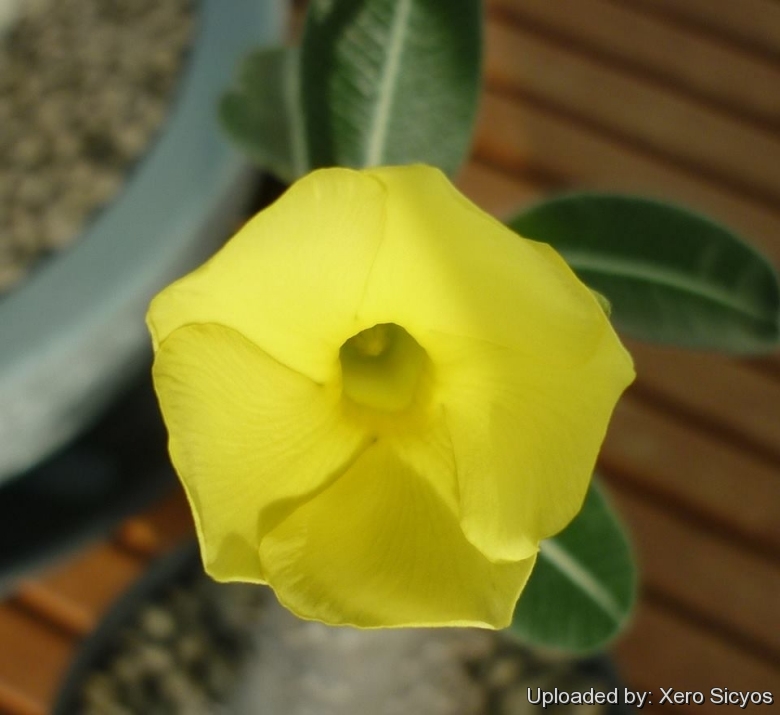Accepted Scientific Name: Pachypodium rosulatum subs. cactipes (K.Schum.) Lüthy
Bradleya 22: 91. 2004 [28 May 2004]

Pachypodium cactipes (Pachypodium rosulatum subs. cactipes) Photo by: Xero Sicyos
Origin and Habitat: Northwest of Fort-Dauphin and adjacent areas, Toliara, southern part of Madagascar.
Altitude range: From 70 metres above sea level.
Habitat and ecology: This species grows on gneiss rocks, in full sun. Accompanied by Aloe schomeri, Aloe bakeri, Tetradenia sp., Euphorbia miliiSN|23360]]SN|23360]] and Rhipsalis bacciferaSN|6426]]SN|6426]].
Synonyms:
See all synonyms of Pachypodium rosulatum
Common Names include:
ENGLISH: Madagascar palm, Millionaire's Daffodils, Elephant's Foot Plant
LITHUANIAN (Lietuvių): Kaktusinis tukvis
Description: Pachypodium cactipesSN|14787]]SN|14787]] may merely represent a southerly form of the Pachypodium rosulatum complex but some authors preferred to recognize it as a distinct species until further research clarifies its affinities. Its rich green glossy foliage, showy yellow flowers on long stems and ease of culture make it one of the more rewarding of the genus.
Habit: Shrub-like up to 1 m high, diameter up to 1.50 m, with a squat pachycaul trunk (inflated base).
Caudex: Spineless, strongly succulent to subglobose and (at least apically) spiny that turns silver grey as it ages. After the plant first flowers, it begins to branch until it forms a head of short, thick, tapered branches with groups of leaves sprouting from the tips of the branches. Young stems more or less erect.
Leaves: The leaves, which fall in the dry season, form a rosette on the top of branches. They are deciduous, very dark green above, white below, margins revolute.
Spines: Weak, needle-like, reddish, conical on the upper half of the plant.
Flowers: Open-faced, canary yellow, at the end of long pedunculate inflorescences, with rather short and wide tubes and hairy ovary. Corolla pale yellow outside, bright yellow inside.
Blooming season: Late winter and early spring before the leaves appear.
Seeds: Narrowly spoon-shaped to oval.
Subspecies, varieties, forms and cultivars of plants belonging to the Pachypodium rosulatum group
Bibliography: Major references and further lectures
1) S. H. J. V. Rapanarivo “Pachypodium (Apocynaceae)” CRC Press, 01 June 1999
2) 3) G. D. Rowley: Pachipodium. In: Urs Eggli: "Illustrated Handbook of Succulent Plants: Dicotyledons." Springer Verlag, 2002
3) Werner Rauh “The Wonderful World of Succulents: Cultivation and Description of Selected Succulent Plants Other Than Cacti” Smithsonian Institution Press, 1984
4) British Cactus and Succulent Society “Bradleya: yearbook of the British Cactus and Succulent Society” Volume 22 The Society, 2004
5) Cactus and Succulent Journal Vol. 76 (2), March - April, 2004
6) John N. Trager. Cactus and Succulent Journal, Vol. 75 (2), March - April, 2003
Cultivation and Propagation: Pachypodium rosulatumSN|14782]]SN|14782]] subs. cactipes is one of the most attractive species in the entire genus that can be grown both indoors, as well as outdoors in warm climates. It’s a moderate grower and an impressive caudex can be steadily developed. In the winters it is deciduous, except in very tropical areas. Pretty cold sensitive- supposedly prone to rot if wet in winter cold. It may be grown as a specimen among rocks and low-growing plants in a hot rockery. It may also be grown in a heavy container on the sunny patio.
Soil: Needs a gritty, porous cactus potting mix that's not strongly acidic.
Watering: Water sparingly in the heat of the growing season to encourage new growth, foliage and flowering, and give extra well-drained soil to avoid waterlogged conditions, no water from late autumn to mid-spring. The watering program will change depending on temperatures and stage of growth, but it is best not to let this plant dry out completely for any length of time. Indoors it is best to keep it on the dry side, or it is prone to rot. Outdoors it must be protected from the rain in winter. Do not let this specimen sit damp in cool weather. The older it gets the less water it must receive!
Hardiness: It is sensitive to cold and should be kept totally dry in winter at or around 10°C, but it demonstrates some cold resilience if dormant and the soil is bone dry in winter. Protect from frost. It tends to lose its leave and go dormant in winter (USDA Hardiness zones: 10 – 11).
Exposure: It like full sun to light shade.
Maintenance: This Pachypodium will not require any pruning to look like a very interesting and unusual bonsai, but after several years it can outgrow its indoor location, requiring a 'pruning'. It has amazing regenerative properties.
Repot: Repot the plant every 3 years; this is quite tricky given all the spines. The best way is to wrap several layers of newspaper around the trunk where it is to be handled.
Warning: This plant has spines use caution when handling.
Propagation: Seeds or (rarely) cuttings. Fresh seeds results in a remarkable yield of new plants, perhaps 90% and seedlings grow fairly easily. Soak seeds in warm water for 24 hours before sowing in a 5 mm deep, sterile, moist sandy medium (4 parts fine and 4 parts coarse river sand 1 part sieved, well-rotten compost; 1 part perlite; 1 part vermiculite. Keep the mix moist and at a temperature of 27–35°C to ensure rapid germination. Seed start sprouting in just 3-4 days ( but continue to germinate erratically for about 6 month) they are also propagated by removal of branches from old plant (if they need to be pruned). They should be allowed to dry for 5 to 8 days before potting up, however the cuttings often fail to root. Seedlings grow fairly slowly compared to other Pachypodium species. Young plants have more conical spines and begin early to swell nicely, branch and even flower.










